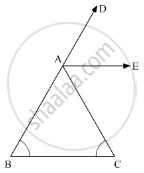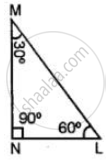Advertisements
Advertisements
प्रश्न
In a ΔABC, if ∠A = 55°, ∠B = 40°, find ∠C.
उत्तर
Given `∠ A=55^@,∠ B=40^@` then ∠ C=?
We know that
In a ABC sum of all angles of triangle is 180°
i.e, ∠ A+∠ B +∠ C =`180^@`
⇒`55^@+40^@` ∠ C `=180^@`
⇒`95^@+∠ C=180^@`
⇒`∠ C=180^@-95^@`
⇒`∠C=85^@`
APPEARS IN
संबंधित प्रश्न
Is the following statement true and false :
A triangle can have two obtuse angles.
In the given figure, AE bisects ∠CAD and ∠B= ∠C. Prove that AE || BC.

In Δ ABC, if u∠B = 60°, ∠C = 80° and the bisectors of angles ∠ABC and ∠ACB meet at a point O, then find the measure of ∠BOC.
In ΔPQR, If ∠R > ∠Q then ______.
Find the unknown marked angles in the given figure:

Find x, if the angles of a triangle is:
x°, 2x°, 2x°
Classify the following triangle according to angle:

P is a point on the bisector of ∠ABC. If the line through P, parallel to BA meet BC at Q, prove that BPQ is an isosceles triangle.
Prove that in a triangle, other than an equilateral triangle, angle opposite the longest side is greater than `2/3` of a right angle.
Can we have two acute angles whose sum is an obtuse angle? Why or why not?
